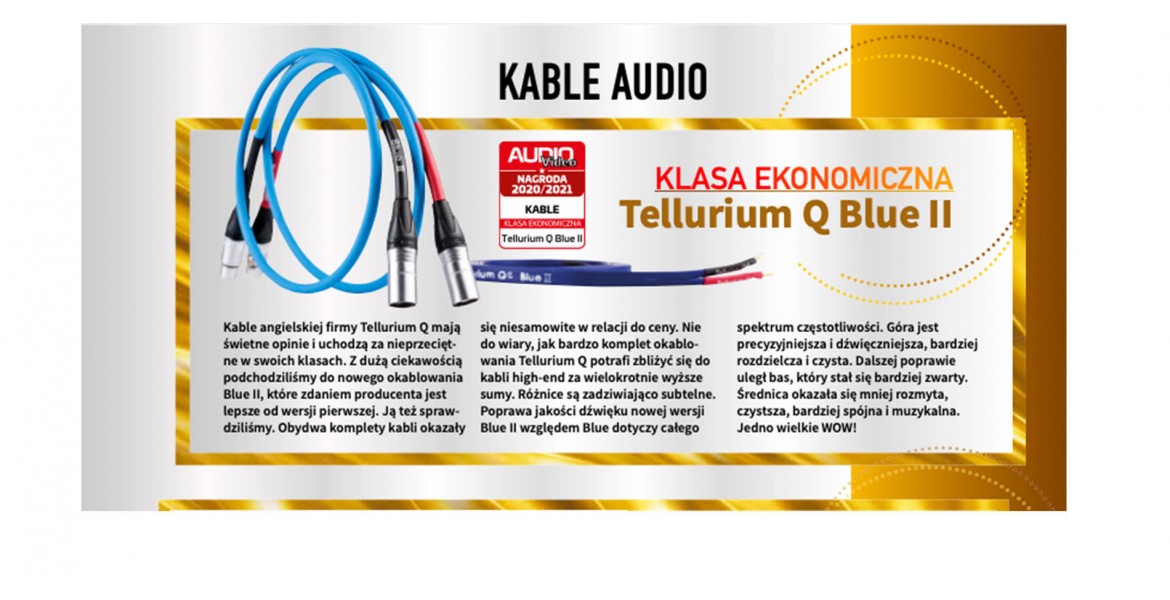- Home
- About us
- Blog
- Shop
-
- Brands
- ALL Brands List
- Acoustical Systems
- Analog Relax
- Antipodes Audio
- Astell & Kern
- Audio Solutions
- AudioByte
- AudioCircle
- Audiomica Laboratory
- Canary Audio
- Canor Audio
- Chameleon Audio
- Clarisys Audio
- CSPort
- Dan D'agostino
- Eversolo
- Farad Power Supplies
- Ferrum Audio
- Fezz Audio
- Fonolab
- Glanz
- HiFiMAN
- HoloAudio
- LAB 12
- LAIV
- LampizatOr
- Magico
- Mega Acoustic
- Monrio Audio
- OLIO SPEC
- Origin Live
- Pachancko Labs
- Phasemation
- Pink Faun
- PLiXIR
- Qualiton
- Questyle
- Reed
- Remton
- Revival Audio
- Riviera Audio
- Rockna Audio
- Sbooster
- Shelter
- Sigma Acoustics
- Signal Projects
- SOtM Audio
- Soulsonic Speakers
- Soundtastic (Struss Audio)
- SPEC
- Synthesis
- Takatsuki
- Tedeska
- Tellurium Q
- Trafomatic Audio
- Tsakiridis Devices
- Volumio
- Second Hand Deals
- Account

Tellurium Q Blue II Review
Tellurium Q cables are visiting me for the second time. Some time ago, the flagship Black Diamond speaker cable amazed me with its properties. The company is based in Somerton (Somerset County), in southwest England. It is headed by Geoff Merrigan, a materials chemistry specialist.
He has made it his mission to combat phase shifts, which is reflected in the company’s motto, displayed prominently on the cardboard packaging: “Phase relationships in a signal is our focus”. Of course, the company has no intention of sharing its know-how with competitors, but this fact would be of little significance were it not for the number of awards Tellurium Q cables have won over the past few years.
The Blue II cables are the cheapest in Tellurium Q’s lineup; they have replaced the Blue models, which the distributor provided for direct comparison. We received the interconnects in balanced versions, which may seem excessive, considering they cost 1,200 PLN for a one-meter pair (the RCA version is 250 PLN cheaper).
Interestingly, the speaker cables are much cheaper – a 2.5-meter pair with BFA (or spade) connectors costs a modest 550 PLN.
BUILD
The Blue and Blue II interconnects have identical thickness and the same connectors (in this case, Neutrik XLR) – silver with gold-plated pins.
They are round in cross-section, covered with a matte, very grippy, and flexible sleeve that feels similar to those used by van den Hul. The Blue was dark blue, while the Blue II has lightened – it is now sky blue. The geometry, conductor, and dielectric used in both versions of the interconnects are company secrets.
Judging by the flexibility, it is likely a cable composed of more thin strands (multi-strand). There are certainly differences in the construction of both interconnects, as indicated by the significantly higher capacitance between the positive pin and the shield in the new version (260 vs. around 90-100 pF). The speaker cables of both generations look identical. They have a purple hue (the name is somewhat misleading) and can only be distinguished by the inscriptions.
They are flat ribbons, 13 mm wide and 3 mm thick. Flexible insulation (probably PVC) was used, making them exceptionally flexible perpendicular to the plane of the cable.
Here, too, the manufacturer does not provide any details about the construction, but based on inspection, it is easy to deduce that we are dealing with two parallel bundles (positive and negative) composed of thin strands. The Blue model has approximately 8% lower resistance.
SOUND
The first part of the listening test was conducted using Revel Performa M126Be monitors. First, I connected the Blue interconnect instead of my reference Equilibrium Pure. Besides the change in sound character, which wasn’t immediately obvious, there was no significant degradation in sound quality. Next, I replaced the van den Hul speaker cable with the Blue, which is 50 times (!) cheaper.
At this point, one would expect a significant drop in sound quality, but that didn’t happen. Aside from a slight “lightening” of the sound, it turned out that this unassuming cable from England maintained a high level of performance. In terms of tone, space, microdynamics, and coherence, the Blue cables presented a level well above expectations. I rated the system’s sound as coherent, musical, and detailed – all these traits were typical of cables on the borderline between categories A and B. Hard to believe? And yet. What impressed me most was the stereophony-related trait, namely the focus. It was astonishingly precise. Vocals were positioned perfectly in the center of the stage.
Monophonic recordings were particularly impressive. Watching films with dialogues coming directly from the actors’ mouths also made a strong impression. Then it was time for the new versions of both cables. It turned out that the super-focused effect largely disappeared, causing some consternation. The Blue II cables played more precisely, with more brightness, but less fluidity. The level of musicality decreased – the sound was less engaging and less comfortable.
I started mixing the cables, old with new. In both cases, the results were averaged and showed only that the change in character towards greater precision applied to both cables. This part of the listening test lasted a total of four days. During breaks, to “calibrate” my hearing, I connected my usual Equilibrium cables, which turned out to be better in every respect, though the scale of the difference in sound was disproportionately small compared to the price disparity.
In the second phase of testing, I connected my work monitors Akkus Redwine 71. On the one hand, they confirmed the very high class of Tellurium Q cables, absolutely outstanding in relation to their price. On the other hand, they revealed some slight limitations of the Blue cables, which, compared to the Equilibrium, introduced slight dulling and blurring, audible across the entire frequency range.
Nonetheless, the sound quality still hovered on the boundary of category A. This made me even more curious about the new models. By the first track, everything became clear, and by the third, I could have ended the test, as the differences between the two generations of the “blue” cables were clear as day. The improvement in sound quality extended across the entire frequency spectrum.
Undoubtedly, the top end of the range was better – more precise, sonorous, detailed, and clean. Although the older versions didn’t lack this, the bass also improved, becoming more precise, tighter, and excellently controlled. The midrange was even more interesting.
It was less blurred, more accurate and cleaner, as well as more coherent and musical. Thus, both the rhythm, tone, resolution, and musicality improved.
IN OUR OPINION
Testing cables is a complicated matter, and the results are not always fully repeatable.
On two different speaker sets, the results were different, which I attribute to the character of the first speakers used (the softer-sounding first-generation Blue paired better with the Revels than the very precise Akkus). Blue II are objectively better cables, but that doesn’t change the fact that both the old and new models are outstanding in their class. It’s gratifying that there are manufacturers who, likely aware of their products’ strengths compared to competitors, don’t hike the price. It’s even more impressive that Blue II aren’t more expensive than their predecessors, and objectively sound better.
In any case, if you’re looking for cables for mid-range or even high-end systems, overlooking these surprisingly affordable cables would be a serious oversight. Editorial choice and the 2020-2021 Award are mere formalities in this case.
Check-out Tellurium Q Cables & Prices HERE!
